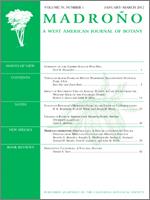Limited information exists regarding the impact of fire on annual plant composition in creosote bush scrub vegetation. The impact of recurrent fires on annual plants is even less understood. To investigate this matter, annual vegetation was sampled in a stand of creosote bush scrub in western Coachella Valley, California that had recently experienced two wildfires. The wildfires fragmented the once contiguous shrubland into three sections: unburned, once-burned, and twice-burned stands, all of which were separated by fuel breaks that contained each fire. For all three stands, annual plant cover and species richness were determined in the field, soil seed bank samples were collected and assayed in a glasshouse, and soil chemistry and physical properties were measured. We found that invasive annual grass cover was highest in the twice-burned stand and native annual plant cover was greatest in the unburned stand. Native annual species richness significantly decreased each time a stand burned resulting in low native annual plant diversity. Seed bank assays revealed that invasive annual grass germinants were orders of magnitude greater in the twice-burned stand compared with the other two stands. Lastly, soil total N, C, and soil pH were elevated in both burned stands. Overall, we found that recurrent fire can result in strong impacts to annual vegetation; however, the twice-burned stand was sampled only three years after burning while the once-burned stand was sampled 20 years after burning. Thus, longer-term fire effect studies plus replication with additional study sites are still needed to improve our understanding of how recurrent fire impacts annual plants.
How to translate text using browser tools
1 January 2012
Impact of Recurrent Fire on Annual Plants: a Case Study from the Western Edge of the Colorado Desert
Robert J. Steers,
Edith B. Allen
ACCESS THE FULL ARTICLE

Madroño
Vol. 59 • No. 1
January 2012
Vol. 59 • No. 1
January 2012
diversity
feedback
grass/fire cycle
invasive plant
richness
seed bank




